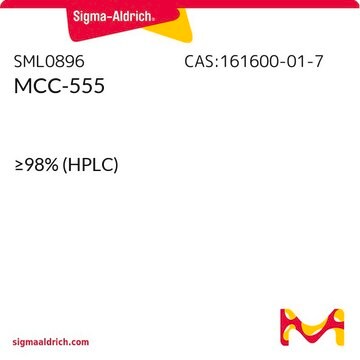Products may be shipped at a different temperature than the recommended long-term storage temperature. If the product quality is sensitive to short-term exposure to conditions other than the recommended long-term storage, it will be shipped on wet or dry-ice. If the product quality is NOT affected by short-term exposure to conditions other than the recommended long-term storage, it will be shipped at ambient temperature. As shipping routes are configured for minimum transit times, shipping at ambient temperature helps control shipping costs for our customers. For more information, please refer to the Storage and Transport Conditions document: https://www.sigmaaldrich.com/deepweb/assets/sigmaaldrich/marketing/global/documents/316/622/storage-transport-conditions-mk.pdf
Kluczowe dokumenty
435236
Cellulose
microcrystalline, powder
Synonim(y):
Cellulose powder, Cotton linters
Wybierz wielkość
436,00 zł
Wybierz wielkość
About This Item
436,00 zł
Polecane produkty
Formularz
microcrystalline
powder
Poziom jakości
wielkość cząstki
51 μm
pH
5-7 (11 wt. %)
gęstość nasypowa
0.6 g/mL (25°C)
ciąg SMILES
O1[C@H](C(C(C(C1CO)O)O)O)O[C@@H]2C(OC(C(C2O)O)O)CO
InChI
1S/C12H22O11/c13-1-3-5(15)6(16)9(19)12(22-3)23-10-4(2-14)21-11(20)8(18)7(10)17/h3-20H,1-2H2/t3?,4?,5?,6?,7?,8?,9?,10-,11?,12+/m1/s1
Klucz InChI
GUBGYTABKSRVRQ-WFVLMXAXSA-N
Szukasz podobnych produktów? Odwiedź Przewodnik dotyczący porównywania produktów
Powiązane kategorie
Zastosowanie
Cechy i korzyści
Kod klasy składowania
11 - Combustible Solids
Klasa zagrożenia wodnego (WGK)
WGK 1
Temperatura zapłonu (°F)
Not applicable
Temperatura zapłonu (°C)
Not applicable
Środki ochrony indywidualnej
Eyeshields, Gloves, type N95 (US)
Wybierz jedną z najnowszych wersji:
Certyfikaty analizy (CoA)
Nie widzisz odpowiedniej wersji?
Jeśli potrzebujesz konkretnej wersji, możesz wyszukać konkretny certyfikat według numeru partii lub serii.
Masz już ten produkt?
Dokumenty związane z niedawno zakupionymi produktami zostały zamieszczone w Bibliotece dokumentów.
Klienci oglądali również te produkty
-
How is shipping temperature determined? And how is it related to the product storage temperature?
1 answer-
Helpful?
-
-
How can I determine the shelf life / expiration / retest date of this product?
1 answer-
If this product has an expiration or retest date, it will be shown on the Certificate of Analysis (COA, CofA). If there is no retest or expiration date listed on the product's COA, we do not have suitable stability data to determine a shelf life. For these products, the only date on the COA will be the release date; a retest, expiration, or use-by-date will not be displayed.
For all products, we recommend handling per defined conditions as printed in our product literature and website product descriptions. We recommend that products should be routinely inspected by customers to ensure they perform as expected.
For products without retest or expiration dates, our standard warranty of 1 year from the date of shipment is applicable.
For more information, please refer to the Product Dating Information document: https://www.sigmaaldrich.com/deepweb/assets/sigmaaldrich/marketing/global/documents/449/386/product-dating-information-mk.pdfHelpful?
-
-
What is the % of lignin contamination?
1 answer-
The amount of lignin contamination is not quantified.
Helpful?
-
-
Hello I'm looking for the molecular weight of this product with Cat. No. 435236 I was wondering if this info is provided in the data analysis? Thanks
1 answer-
Unfortunately, the molecular weight of this product has not been determined.
Helpful?
-
-
Hello, I would like to know, is this MCC powder a fiber or particle?
1 answer-
As mentioned in the 'PROPERTIES' section and on the lot specific Certificate of Analysis (COA), this product is offered in powered format. The particle size distribution is lot specific and reported in the Certificate. Please refer to Cellulose product numbers C6288 and S6790 should the fiber form be of interest.
Helpful?
-
-
Does 51um refer to the diameter or length of the particle?
1 answer-
The particle size range for this product is reported on the lot-specific Certificate of Analysis with the specification being less than 10% at 250 um and greater than 40% being 74 um. The 51 um generally refers to the diameter, however this is the only particle size measure available.
Helpful?
-
-
Are all MCC on your portfolio extracted from wood pulp or are there other plant based MCCs as well?
1 answer-
Source of origin information for Microcrystalline cellulose and other products is best provided on a product-specific, lot-specific basis via a Certificate of Origin (CofO). If the information on source is required prior to ordering, please contact your local Technical Service group to see which lot(s) would be available to you, and to see if CofOs are available.
Helpful?
-
-
From where it is extracted can u tell me details sir
1 answer-
This product is extracted from wood pulp.
Helpful?
-
-
What is the particle size of the product 435236, Cellulose?
1 answer-
The particle size for product 435236, Cellulose is 51 μm, per the supplier.
Helpful?
-
-
What is the Department of Transportation shipping information for this product?
1 answer-
Transportation information can be found in Section 14 of the product's (M)SDS.To access the shipping information for this material, use the link on the product detail page for the product.
Helpful?
-
Active Filters
Nasz zespół naukowców ma doświadczenie we wszystkich obszarach badań, w tym w naukach przyrodniczych, materiałoznawstwie, syntezie chemicznej, chromatografii, analityce i wielu innych dziedzinach.
Skontaktuj się z zespołem ds. pomocy technicznej



